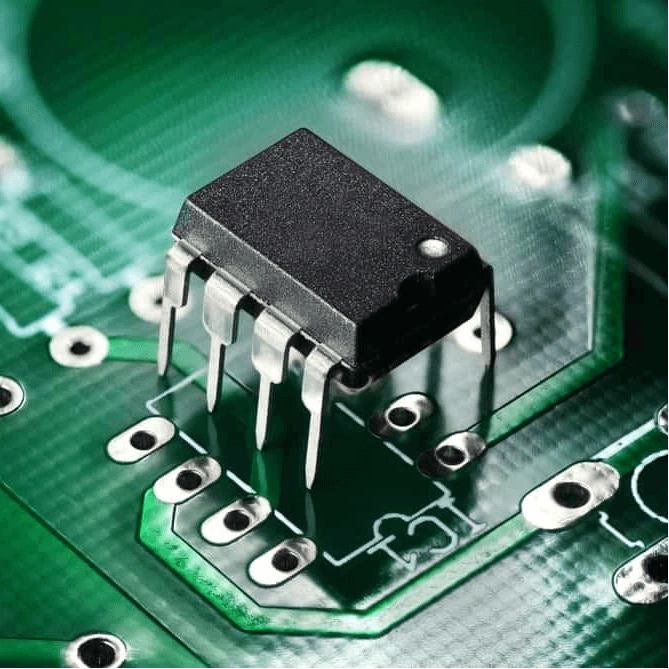
What is FR-4?
FR-4 is a widely used composite material in the electronics industry, primarily serving as a substrate for printed circuit boards (PCBs). The designation “FR-4” refers to a flame-retardant (FR) glass-reinforced epoxy laminate, where the “4” indicates the thickness of the woven glass fabric in ounces per square foot. The glass fabric provides structural strength and rigidity, while the epoxy resin binds the layers together, creating a durable and reliable composite material. FR-4’s flame-retardant properties make it resistant to ignition and self-extinguishing under flame exposure, ensuring enhanced safety in electronic applications.
History and Development of FR-4
FR-4 was first introduced in the 1950s by the National Electrical Manufacturers Association (NEMA) as a flame-resistant laminate for electrical insulation. Early versions used phenolic resin, which lacked sufficient flame resistance and was prone to moisture-induced delamination. The introduction of epoxy resin in the 1960s revolutionized FR-4 materials, providing superior thermal stability, mechanical strength, and flame retardancy. Over the decades, FR-4 has become the dominant PCB substrate, now accounting for more than 90% of the global market. Modern FR-4 laminates are available in various thicknesses, copper weights, and dielectric properties to meet diverse electronic design requirements.
Key Applications of FR-4
FR-4’s combination of mechanical strength, electrical insulation, thermal stability, and chemical resistance makes it ideal for a wide range of electronic devices. It is extensively used in consumer electronics, including smartphones, laptops, tablets, and televisions, as well as in industrial, automotive, aerospace, and medical applications. Beyond PCBs, FR-4 also reinforces mechanical components and is used in devices such as LEDs, transformers, and battery packs.
Physical and Chemical Properties
FR-4 laminates are composed of epoxy resin and woven glass fiber cloth, supplemented with additives and fillers to optimize performance. The material exhibits high tensile and flexural strength, excellent dimensional stability, low water absorption, and strong chemical resistance against acids, bases, and solvents. FR-4 also maintains its properties under high humidity and temperature variations and meets flame-retardant standards like UL 94V-0.
Technical Specifications of FR-4
Dielectric constant (εr): 4.2 – 4.8
Dissipation factor (tan δ): 0.015 – 0.035
Thermal conductivity: 0.3 – 0.4 W/m*K
Water absorption: <0.10%
Glass transition temperature (Tg): 130 – 180°C
Operating temperature: -40 to 130°C
Copper peel strength: >1.0 N/mm
Surface resistivity: >10^12 Ω/sq
FR-4 is available in standard, mid-Tg, and high-Tg variants, each offering different thermal properties. Mid-Tg and high-Tg FR-4 laminates are suitable for high-temperature applications, providing lower thermal expansion and better stability under thermal stress, making them ideal for high-frequency or aerospace electronics.
FR-4 PCB Design Considerations
Selecting the right FR-4 PCB involves considering thickness, trace width and spacing, copper weight, via size and placement, solder mask, and silkscreen printing. Standard thickness ranges from 0.4mm to 3.2mm, with 1.6mm being most common. Correct selection ensures mechanical strength, optimal thermal management, and electrical reliability. Proper ground plane design, trace layout, and material selection are critical to minimizing noise, crosstalk, and signal integrity issues in high-speed circuits.

FR-4 PCB Manufacturing Process
The fabrication of FR-4 PCBs involves several key steps:
Material Preparation: Cutting FR-4 sheets to size and drilling holes for components and vias.
Copper Cladding: Electroplating thin copper layers on one or both sides.
Photoresist Application and Photolithography: Defining copper traces and pads using UV exposure.
Etching and Plating: Removing excess copper and protecting circuits with solderable coatings.
Solder Mask and Silkscreen Printing: Protecting the board and adding markings for assembly.
Surface Finish: Enhancing solderability and long-term durability.
Quality control measures, including electrical testing, X-ray inspection, and visual evaluation, are implemented at every stage to ensure high reliability and compliance with industry standards.
Advantages of FR-4 PCBs
FR-4 PCBs offer excellent electrical insulation, mechanical durability, thermal stability, chemical resistance, low water absorption, cost-effectiveness, and easy manufacturability. These advantages make FR-4 suitable for applications ranging from consumer electronics to aerospace and automotive electronics, providing reliability under harsh operational conditions.
Applications Across Industries
Consumer Electronics: Smartphones, computers, TVs, and home appliances.
Industrial Equipment: Machinery control systems and automated devices.
Aerospace and Defense: Lightweight, high-strength PCBs for navigation, communication, and avionics.
Automotive Electronics: Engine control modules, infotainment systems, and safety electronics.
FR-4 remains a versatile, cost-effective, and high-performance substrate material for PCB design, with various grades tailored to specific thermal and electrical requirements.
For more detailed information on FR-4 materials, technical specifications, and customized PCB solutions, YILONG INSULATION provides expert guidance and high-quality FR-4 laminates suitable for diverse electronics manufacturing needs. Please feel free to contact us at yilong@yilonginsulation.com and visit our website www.yilonginsulation.com.